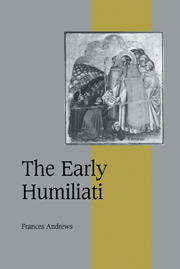Book contents
- Frontmatter
- Contents
- Acknowledgements
- List of abbreviations
- Map
- Introduction
- 1 Tradition and history
- 2 The beginnings of the Humiliati: the twelfth-century evidence
- 3 Quia in nullo peccabant: the inspection and approval of the Humiliati 1199–1201
- 4 Rules
- 5 In search of communities
- 6 New members and profession of vows
- 7 Unity and uniformity: the development of a centralised order
- 8 The Humiliati and the Church in the localities
- Conclusion
- Appendices
- Bibliography
- Index
- Cambridge Studies in Medieval Life and Thought: Fourth Series
8 - The Humiliati and the Church in the localities
Published online by Cambridge University Press: 02 November 2009
- Frontmatter
- Contents
- Acknowledgements
- List of abbreviations
- Map
- Introduction
- 1 Tradition and history
- 2 The beginnings of the Humiliati: the twelfth-century evidence
- 3 Quia in nullo peccabant: the inspection and approval of the Humiliati 1199–1201
- 4 Rules
- 5 In search of communities
- 6 New members and profession of vows
- 7 Unity and uniformity: the development of a centralised order
- 8 The Humiliati and the Church in the localities
- Conclusion
- Appendices
- Bibliography
- Index
- Cambridge Studies in Medieval Life and Thought: Fourth Series
Summary
The relationship between the Humiliati and the Church in the localities, both secular and regular, is fundamental to understanding their identity as a religious order. Some recent studies have considered the situation in individual towns, but no attempt has yet been made to present a broader perspective. New sources are continually appearing and will in future modify details of the account which follows. Nonetheless, it is worth constructing a framework, both as a counterweight to the view of the Humiliati as more or less exclusively a society of manufacturing and commercial experts, administrators and opportunists and to illustrate the nature of the order as an important, if localised, part of the Church.
As has already been argued, the evidence for the Humiliati in the twelfth century shows that they were closer to the establishment of the Church than hitherto recognised. Indeed, after 1201, it was arguably their status as religiosi, as trustworthy members of the ecclesiastical establishment, which led to their appointment to communal offices and underlay their relationship with the laity studied by Zanoni. A first step, therefore, towards understanding their impact on the ordinary people of the towns of northern Italy is to establish the contours of their relationship with the institution inside which they operated: that is, within the Church.
It is not easy to isolate this relationship with the local Church, since neither institution was in any sense a homogeneous unit. Even the policies and actions of the papacy, which were in theory centrally directed, so that a single strategy may be identified during a particular pontificate, undoubtedly suffered the impact of inertia.
- Type
- Chapter
- Information
- The Early Humiliati , pp. 220 - 247Publisher: Cambridge University PressPrint publication year: 2000



